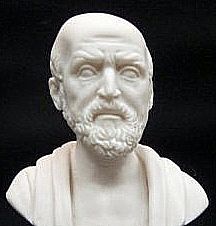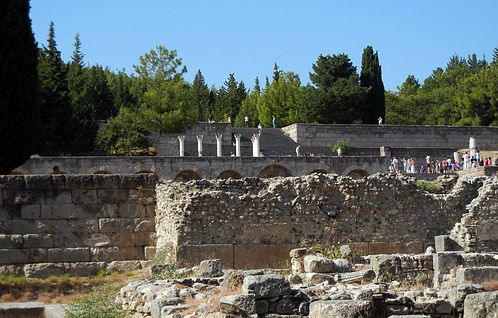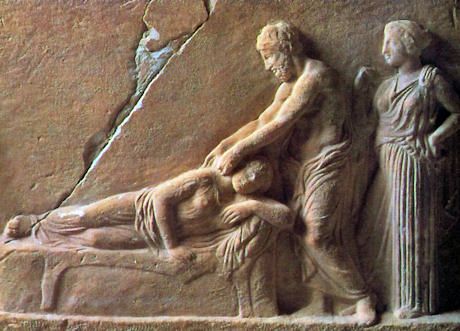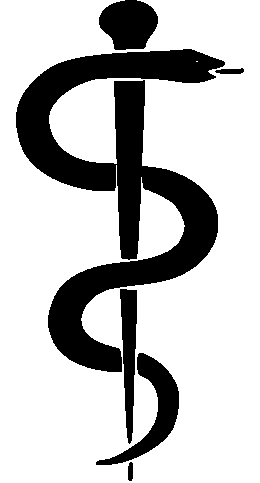Content created: 2011-09-11
File last modified:
Hippocrates
Comments on Medicine

Outline
Procursus
Hippocrates (Ἱπποκράτης, hipp-POCK-ruh-teez), hailed even in antiquity as the “father of medicine,” left no writings. He is known to us in part from the writings of Plato and appears to have been of the same generation as Socrates.
According to Plato, he was descended from a family on the island of Cos (or Kos) off the southwestern coast of Turkey, the site of antiquity's greatest shrine, shown below, to the god of medicine, Asclepius (Greek: Asklepios [Ασκληπιος], Latin: Aesculapius ). Hippocrates' family rather fancifully claimed descent from Asclepius, and seems to have been in the business of medicine and healing. Hippocrates presumably traveled to Athens because it was where the action was.
Legends dating from the centuries just after Hippocrates’ death added that
- He was also descended from the legendary Hercules
- He studied medicine with all the teachers of his age and traveled the whole world studying and healing.
- He drove the plague from Athens.
- He healed a Macedonian king afflicted by love. (Love was often considered a painful and debilitating disorder in the Greek thought. That is why Cupid carries arrows.)
- Inspired by patriotism toward the Greek world, he refused to cure the king of Persia of old age. (Kings of Persia were considered unworthy to live at all, let alone to be cured of old age.)
Hippocrates’ (putative) tomb in Thessaly was still held responsible for medical miracles as late as the IInd century AD, when it was apparently visited by the anti-Christian writer Celsus (not to be confused with Anders Celsius, inventer of the temperature scale). Celsus reported that honey from the bees who had taken up residence around the tomb was able to heal disorders of the mouth.

The works once attributed to Hippocrates, now discretely entitled The Hippocratic Collection, are assumed all to be later compositions mendaciously attributed to him, some probably composed by physicians in Cos shortly after his death, some as late as the 200s AD, when the Collection was compiled in the Egyptian city of Alexandria. They are assumed to represent his perspective on illness and healing, and even his remarkably close observation and insight, and it is usual to proceed as though the writings were actually from his hand, for the writers clearly sought to represent him well.
Several points should be noted:
- One is that Hippocrates saw illness in the context of a person’s whole body, not merely the affected part. This was informed by an erroneous theory of “humors” that was a basis of Greek and subsequent medicine, but he thought critically even of this theory and sought to defend it where it seemed inappropriately dismissed. In the first selection below, one can see his insistence that one should be a careful “splitter” and not a careless or premature “lumper” in considering bodily fluids and excrescences. Otherwise one will misunderstand what is going on. (For a brief essay on splitting and lumping, click here.)
- He was also concerned to see disease as a physical thing, located in the body of the sufferer, or perhaps sometimes the mind. (He considered debilitating anxiety to be an illness, for example, a view becoming mainstream in medicine less than half a century ago.) In the second selection here we see his annoyance at the notion that the mysterious illness we now call epilepsy should be named a “sacred malady,” as though gods or demons had anything whatever to do with it.
- He was sensitive to the context in which disease occurred and to the notion that diseases did not strike randomly. In the third selection here, from an essay on epidemics, we see him carefully recording the progress of various widespread illnesses as they link to weather.
- Finally, in a world of opportunistic “doctors”, he was concerned that the physician at all times keep the welfare of the patient uppermost in his mind. (Click me.)
That is what he is most famous for today, and that is why the oath sworn on graduation from medical school is called the “Hippocratic Oath.” The modern text of the oath differs from the original, a fact rarely noticed by most who swear it. The UCSD version and the “original” Alexandria version are provided here.
The paragraph numbering within the selections on this page is for convenience in on-line reading or class discussion. It does not correspond to standard editions of the Greek text.
Return to top.
Selection 1: The Elements of Life
1. I promised to demonstrate that the principles [substances] that constitute human beings are still the same, both in the language used and in nature. Yet I say that they are blood, phlegm, and yellow and black bile. First, let us note that in ordinary usage these humors have distinct names which must not be confounded. Further, in nature, their appearances are no less diverse, and the phlegm is not like blood, nor the blood like bile, nor the bile like phlegm.
2. Indeed, what similarity would there be between substances which do not present the same color to our sight or the same feeling to our touch, being neither hot nor cold nor dry nor wet in the same way? And so, with such dissimilarity in appearance and properties, they can’t be identical, not if it is true that fire and water are not a single substance.
…
Retranslated by DKJ from
É. Littré 1849 Hippocrate: Nature de l’homme.
Return to top.
Selection 2: Epilepsy: The “Sacred” Malady
1. As to the malady called divine or “sacred,” here is what is involved: It seems to me no more divine or sacred than others; it has the same character as other maladies, and the same root causes as the others. People have attributed a divine nature and cause to it out of ignorance and because of the surprise that it inspires in them, for it bears little resemblance to ordinary diseases.
2. Further, on the one hand, because of the difficulty of knowing it well, they have continued to attach something divine to it. On the other, because of the therapeutic method used against it (for it has been treated with purifications and enchantments) they are happy to take on treating it. If something need only be surprising to be considered divine, there would be not a single “sacred,” but a whole host of them. I can mention some that are no less amazing, no less prodigious, and yet that no one would dream of considering “sacred.”
3. For example: ordinary fevers lasting three or four days seem to me no less sacred, no less likely to have a divine origin than the “sacred malady,” even though they excite no surprise. Another example: I see people sometimes become, without cause, manic and insane, doing a lot of strange things.
4. I know that there are some such people who groan and cry in their sleep; some who feel they are suffocating; others who get out of bed, leave the house, and wander until they wake up, after which they are quite healthy, except a little pale and weak. These cases occur not once, but quite often. There are many others, all different, and it would take too long to discuss them all.
5. Those who first attribute sacredness to this malady I would compare to today’s magicians, purifiers, jugglers, charlatans, indeed to all people who pretend to be very pious and to know more [than the rest of humanity]. Proposing divinity to veil their inability to prescribe an effective remedy against epilepsy and not to make their ignorance obvious to everyone, they therefore imagine that the malady is “sacred”!
6. This malady is therefore in my opinion no more divine than other illnesses; it has the same nature as the rest, and has originated from the same occasional cause as the others. It comes about from the same circumstances as everything else does. And it is no less treatable than other illnesses, so long as it has not become so fortified by time as to be able resist remedies that one uses against it. It has its origin in heredity, just like other illnesses.
…
Retranslated by DKJ from
Ch. V. Daremberg 1844 Hippocrate: Maladie sacrée.
Return to top.
Selection 3: Of Epidemics
1. … The spring was cold, northerly, rainy, and clouded; the summer was not very sultry, the Etesian winds blew constant, but quickly afterwards, about the rising of Arcturus, there were again many rains with north winds.

2. The whole season being wet, cold, and northerly, people were, for the most part, healthy during winter; but early in the spring very many, indeed, the greater part, were valetudinary. At first ophthalmies set in, with rheums, pains, unconcocted discharges, small concretions, generally breaking with difficulty, in most instances they relapsed, and they did not cease until late in autumn.
3. During summer and autumn there were dysenteric affections, attacks of tenesmus and lientery, bilious diarrhoea, with thin, copious, undigested, and acrid dejections, and sometimes with watery stools; many had copious defluxions, with pain, of a bilious, watery, slimy, purulent nature, attended with strangury, not connected with disease of the kidneys, but one complaint succeeding the other; vomitings of bile, phlegm, and undigested food, sweats, in all cases a redundance of humors. In many instances these complaints were unattended with fever, and did not prevent the patients from walking about, but some cases were febrile, as will be described. In some [patients] all those described below occurred with pain.
4. During autumn, and at the commencement of winter, there were phthisical complaints, continual fevers; and, in a few cases, ardent; some diurnal, others nocturnal, semi-tertians, true tertians, quartans, irregular fevers.
5. All these fevers described attacked great numbers. The ardent fevers attacked the smallest numbers, and the patients suffered the least from them, for there were no hemorrhages, except a few and to a small amount, nor was there delirium; all the other complaints were slight; in these the crises were regular, in most instances, with the intermittents, in seventeen days; and I know no instance of a person dying of causus, nor becoming phrenitic.
6. The tertians were more numerous than the ardent fevers, and attended with more pain; but these all had four periods in regular succession from the first attack, and they had a complete crisis in seven, without a relapse in any instance. …
…
7. People died of all these diseases, but mostly of these fevers, and notably infants just weaned, and older children, until eight or ten years of age, and those before puberty. These things occurred to those affected with the complaints described above, and to many persons at first without them. The only favorable symptom, and the greatest of those which occurred, and what saved most of those who were in the greatest dangers, was the conversion of it to a strangury [definition], and when, in addition to this, abscesses were formed.

8. The strangury attacked, most especially, persons of the ages I have mentioned, but it also occurred in many others, both of those who were not confined to bed and those who were. There was a speedy and great change in all these cases. For the bowels, if they happened previously to have watery discharges of a bad character, became regular, they got an appetite for food, and the fevers were mild afterwards. But, with regard to the strangury itself, the symptoms were protracted and painful. Their urine was copious, thick, of various characters, red, mixed with pus, and was passed with pain. These all recovered, and I did not see a single instance of death among them.
9. With regard to the dangers of these cases, one must always attend to the seasonable concoction of all the evacuations, and to the favorable and critical abscesses. The concoctions indicate a speedy crisis and recovery of health; crude and undigested evacuations, and those which are converted into bad abscesses, indicate either want of crisis, or pains, or prolongation of the disease, or death, or relapses; which of these it is to be must be determined from other circumstances.
10. The physician must be able to tell the antecedents, know the present, and foretell the future, must meditate these things, and must have two special objects in view with regard to diseases, namely, to do good or to do no harm.
11. The art consists in three things: the disease, the patient, and the physician. The physician is the servant of the art, and the patient must combat the disease alongside the physician.*
[*Translator’s note: Galen, in his Commentary, … informs us that in some of the manuscripts instead of “art” he found “nature”; that is to say, that the physician is “the minister (or servant) of nature.”]
Translated by Francis Adams (1796-1861).
Hippocrates: Of the Epidemics, Book 1 §2 Paragraph 1-2, 4.
Return to top.
Selection 4: The Modern Hippocratic Oath
(Click the snake to learn more about why it is here.
Click
here to see this section with the Greek text. )
The Modern ("Modified Geneva") Version
(as administered to the UCSD Medical School MD graduating class of 2005)
(Lettering and numbering have been added to facilitate discussion.)

- Now being admitted to the profession of medicine,
- I solemnly pledge to dedicate my life in the service of humanity I will give respect and gratitude to my deserving teachers. I will practice medicine with conscience and dignity.
- The health and life of my patient will be my first consideration. I will hold in confidence all that my patient confides in me.
- I will maintain the honor and the noble traditions of the medical profession. I will not permit consideration of race, religion, nationality, ideology, or social standing to intervene between my duty and my patient.
- I will maintain the utmost respect for human life and its quality. Even under threat, I will not use my knowledge contrary to the laws of humanity. These promises I make freely and upon my honor.
Ancient ("Original") Version
- I swear by Apollo the physician, and Aesculapius, and Hygieia (Health), and Panacea (All-heal), and all the gods and goddesses, that, according to my ability and judgment, I will keep this Oath and this stipulation:
- to reckon him who taught me this Art equally dear to me as my parents, to share my substance with him, and relieve his necessities if required; to look upon his offspring in the same footing as my own brothers, and to teach them this art, if they shall wish to learn it, without fee or stipulation; and that by precept, lecture, and every other mode of instruction, I will impart a knowledge of the Art to my own sons, and those of my teachers, and to disciples bound by a stipulation and oath according to the law of medicine, but to none others.
- I will follow that system of regimen which, according to my ability and judgment, I consider for the benefit of my patients, and abstain from whatever is deleterious and mischievous.
- I will give no deadly medicine to any one if asked, nor suggest any such counsel; and in like manner I will not give to a woman a pessary to produce abortion.
- With purity and with holiness I will pass my life and practice my Art. I will not cut persons laboring under the stone, but will leave this to be done by men who are practitioners of this work [professional torturers].
- Into whatever houses I enter, I will go into them for the benefit of the sick, and will abstain from every voluntary act of mischief and corruption; and, further from the seduction of females or males, of freemen and slaves.
- Whatever, in connection with my professional practice or not, in connection with it, I see or hear, in the life of men, which ought not to be spoken of abroad, I will not divulge, as reckoning that all such should he kept secret.
- While I continue to keep this Oath unviolated, may it be granted to me to enjoy life and the practice of the art, respected by all men, in all times! But should I trespass and violate this Oath, may the reverse be my lot!
Translated by Francis Adams (1796-1861).
Return to top.
An interactive quiz is available to doublecheck your understanding of the first three selections on this page. It is divided into two short ("wimp") versions. For the more ambitious, the questions from both of them have been combined into a single "hero" version.
Quiz 1,
Quiz 2,
Hero Quiz
Return to top.




